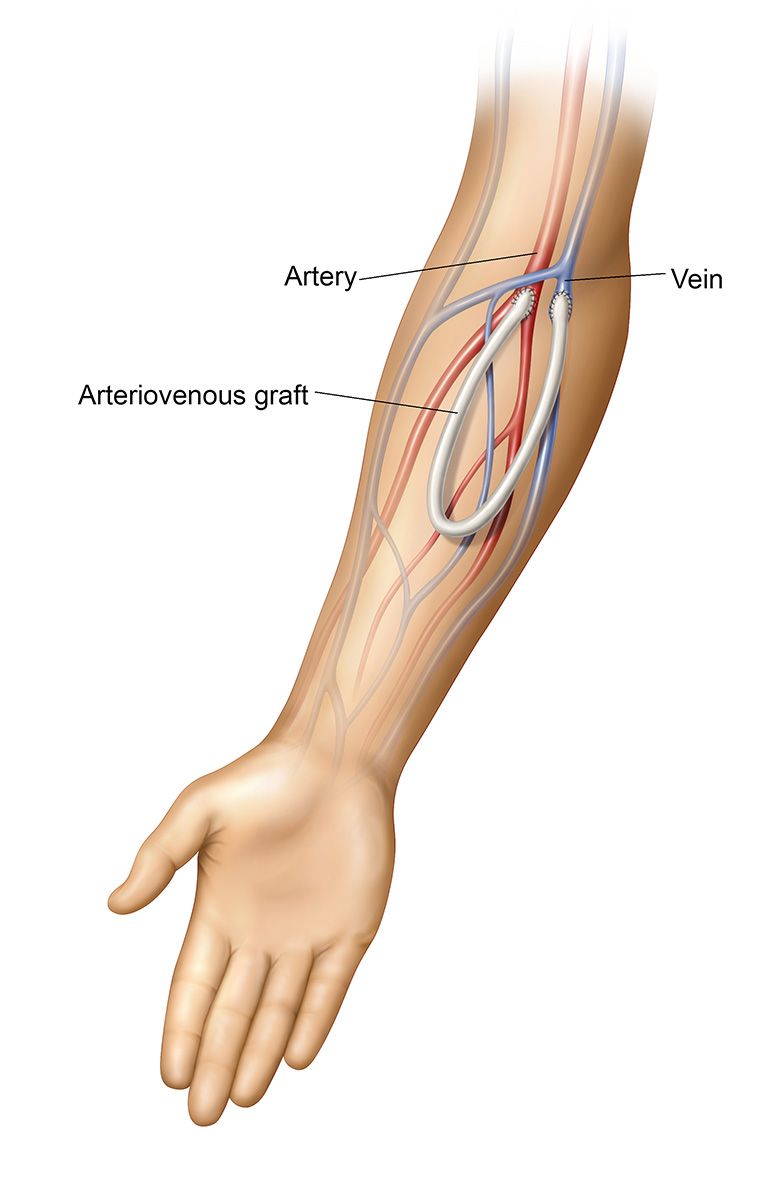If you have been diagnosed with ESRD and need to begin dialysis, an access is required. One of the options is an arteriovenous (AV) graft. According to the 2015 United States Renal Data System’s report, within 1 year of hemodialysis initiation, about 15% of people on dialysis were using a graft.
What is an AV graft?

An arteriovenous (AV) graft is a type of access used for hemodialysis. The graft is usually placed in the arm, but may be placed in the leg if necessary. An AV graft is the connection of a vein and an artery that utilizes a hollow, synthetic tube (the actual “graft”). One end of the tube is connected to an artery and the other end of the tube is connected to a vein. This connection results in blood flowing from the high flow, high pressure artery through the graft and into the low flow, low pressure vein. As a result the blood flow through the graft provides a flow rate that will deliver enough blood to provide an adequate hemodialysis treatment.
What is the procedure for placing an AV graft?
Local anesthesia is administered to the area selected for graft placement. The physician makes two small incisions in order to access the artery and vein. Next, one end of the graft is surgically connected to the artery, the other end is connected to the vein. Once placed, blood now flows from the artery, through the graft and into the vein. This allows needles to be placed into the graft for hemodialysis.
Advantages of an AV graft:
- An AV graft provides a solution for small or weak veins.
- An AV graft can be used as soon as two to four weeks after placement.
- AV graft surgery is usually done on an outpatient basis, under local anesthetic, allowing for a rapid and easy recovery.
Are you a candidate for an AV graft?
While an AV fistula is considered the access of choice by most people in the vascular field, an AV graft is a close second and may be the best choice for certain people. For instance, if your veins are too small for a fistula to properly develop or if your veins are not healthy, you would be a better candidate for an AV graft.
If you are on dialysis or you may be starting in the future, you may be a candidate for AV graft placement. If you think you may be a candidate for a graft or have questions about whether this access type is right for you, be sure to speak with a physician.
Recovering from the AV graft placement procedure
After the procedure, your physician will instruct you to keep your arm elevated, either by raising it or propping it with a pillow to reduce swelling and pain at the access site. You may feel some slight discomfort or swelling in your arms for a few days, but this is not uncommon. If you are able to feel a slight vibration (thrill) through your bandage this means your graft is working properly.
How we can help you
Our interventional specialists and vascular surgeons specialize in creating, placing and maintaining dialysis accesses. We perform minimally invasive AV graft placement procedures in our outpatient vascular centers. At Azura Vascular Care, we work every day to deliver far more than our patients expect. We bring our full range of medical capabilities and service excellence to every patient, every visit at each of our centers nationwide.
If you would like to learn more about a specific medical condition leading to dialysis, or about dialysis itself, Fresenius Kidney Care is a complete resource for CKD.
If you are ready to consult with one of our specialists, find a center near you or search for one of our physicians.
Ready to Speak with a Specialist?
Search for a center or physician in your area and request an appointment online.